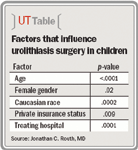Article
Children's stone treatment varies widely by hospital
For the past 9 years, a steady increase in the number of children being diagnosed with urolithiasis has been accompanied by an equally steady increase in the ratio of those children undergoing surgery for the condition.
Washington-For the past 9 years, a steady increase in the number of children being diagnosed with urolithiasis has been accompanied by an equally steady increase in the ratio of those children undergoing surgery for the condition, according to a study from Children's Hospital, Boston.

Of these, the hospital treating the patient was by far the strongest determinant as to whether he or she would undergo surgery for stones. The probabilities of surgery ranged from 24% (95% CI: 16%-34%) in institutions at the low end of the treatment spectrum to 95% (95% CI: 74%-99%) at the high end.
"You would imagine that if a child comes into a hospital with a 2-mm stone, the odds would be that he or she would be treated more or less the same way regardless of the institution. But what this comes down to is that the hospital to which parents happen to take their child is really the major driver behind the type of procedure or lack of procedure that their child receives," said Dr. Routh, who presented the study at the American Academy of Pediatrics Section on Urology annual meeting.
Hospital influences CT use
The treating hospital also exerted a strong influence on CT use, with usage rates ranging from 45% to 85%, "a dramatic difference," said Dr. Routh.

CT use during the 9 years covered by the study increased from 21% of cases to 45%, while kidney, ureter, bladder (KUB) radiography fell from 65% to 36%. Ultrasound use declined from 37% to 24% of cases, while MRI use remained stable (1.9% to 1.6%).
Dr. Routh called attention to a recent study published in the Journal of Urology (2009; 182:1829-34) that compared CT to ultrasound. The authors of that study concluded that although CT produced more detailed images, the utility of the two technologies in determining which therapeutic procedures were to follow was not significantly different.
Female gender exerted only a minor influence on decisions.
"The odds ratio for female gender was low [1.1], which means we found only a 10% increase in the odds of surgery. Because this is an observational cohort, it is entirely possible that that there is an unidentified confounder underlying gender. You have to take observational data with a grain of salt," Dr. Routh cautioned.
Patient race a factor
The study found that Caucasian children were twice as likely to undergo surgical intervention than were African-American (RR: 2.1, p=.02) or Latino children (RR: 2.1, p=.02).
"Clearly, there is a linkage between socioeconomic status and race. The impact of these on medical care has been documented time and again in this country. The indicators that we used [for this study] were a bit blunt. We were only able to look at self-reported race and whether the patient was privately or publicly insured. There are other factors, such as educational and income levels, that may have influenced our findings, but this still worries me," said Dr. Routh.
Dr. Routh said that at present, the absence of clear guidelines gives pediatric urologists a wide latitude in making clinical decisions. Although AUA updated its urolithiasis treatment guidelines for adults as recently as 2007, it has yet to develop guidelines for pediatric patients.




